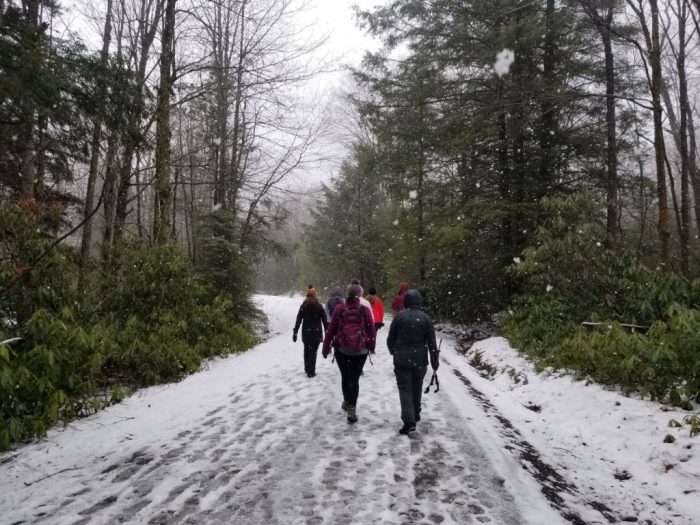How to Train for Hiking: 5 Moves to Get You into Hiking Shape
**This post supports our new Explorer Chick Fit program in collaboration with certified training professional, Ulrike Rosser.
Many of us have seen a picture of a beautiful mountain vista, or a collection of Explorer Chicks waving from some wide open space, and immediately thought—I want to do that too!! Some of the best experiences in life come from being on the trail during backpacking trips and day hikes, but for many of us, hopping off the couch and heading straight to the trailhead simply isn’t going to work. (Not without a whole lot of post-hike stiffness at least!)
So what does that starting position look like if you’re trying to crush your first backpacking trip or simply conquer some uneven terrain on the weekends? That’s what we’re going to get into in this post! We’ll cover why pre trip training is so important, the essentials for how to train for hiking, and what a training routine might look like for you.
Why You Should Train for Hiking
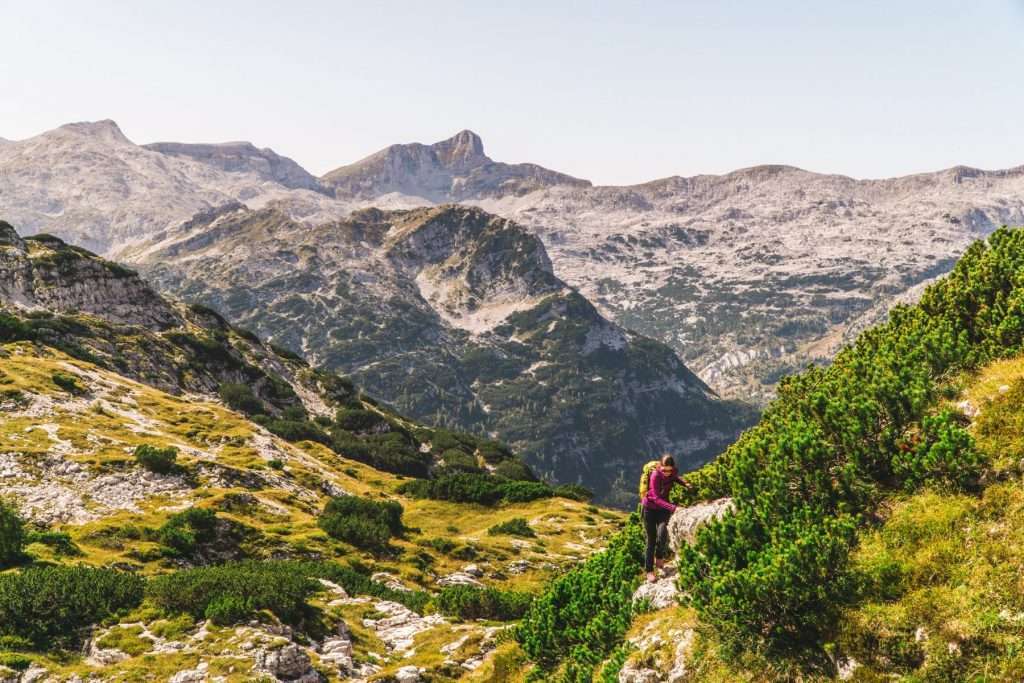
Hiking is a full body exercise, so just hitting the trails for lots of training hikes and hoping it strengthens you up might not work as planned. Sometimes it’s all you need, but most of the time a little off-trail training will make your hiking experiences that much better.
You probably already know it requires strong leg muscles to get you up and down the mountain — you need them to step up, step down, and maintain your balance all the way through the hike. But hiking also requires a lot of standing, which can put pressure on your lower back or your hips. And let’s not forget about carrying water and snacks in a daypack (or bringing that extra gear for backpacking), which means upper body stability and strength is also essential for challenging hikes. Sore shoulders or a tight neck don’t equal a great hiking experience!
So if you’re going to strap on those hiking boots and go for challenging, longer hikes, you need a full body training plan.
Benefits of Having a Workout Routine for Hiking
Still not convinced you can’t just strap on the pack weight and put your best foot forward on the trail? Sure, you might be able to. But if you want to supercharge those gains, keep in mind that off-trail training can have all these additional benefits:
- Strengthens lower body muscles so you have less pain or soreness on the trail.
- Builds endurance so you can go on longer hikes.
- Improves balance and stability for those rocky trails.
- Reduces risk of injury. When you’re on the trail, having those stronger stability muscles can reduce your risk of rolling an ankle or taking a fall on the trail.
5 Exercises to Adapt Your Muscles to the Trail
- Step Ups
- Reverse Lunges to Kickback
- Seated Rotations
- Overhead Squat with Raised Arms
- Sumo Squat with Calf Raises
Step Ups

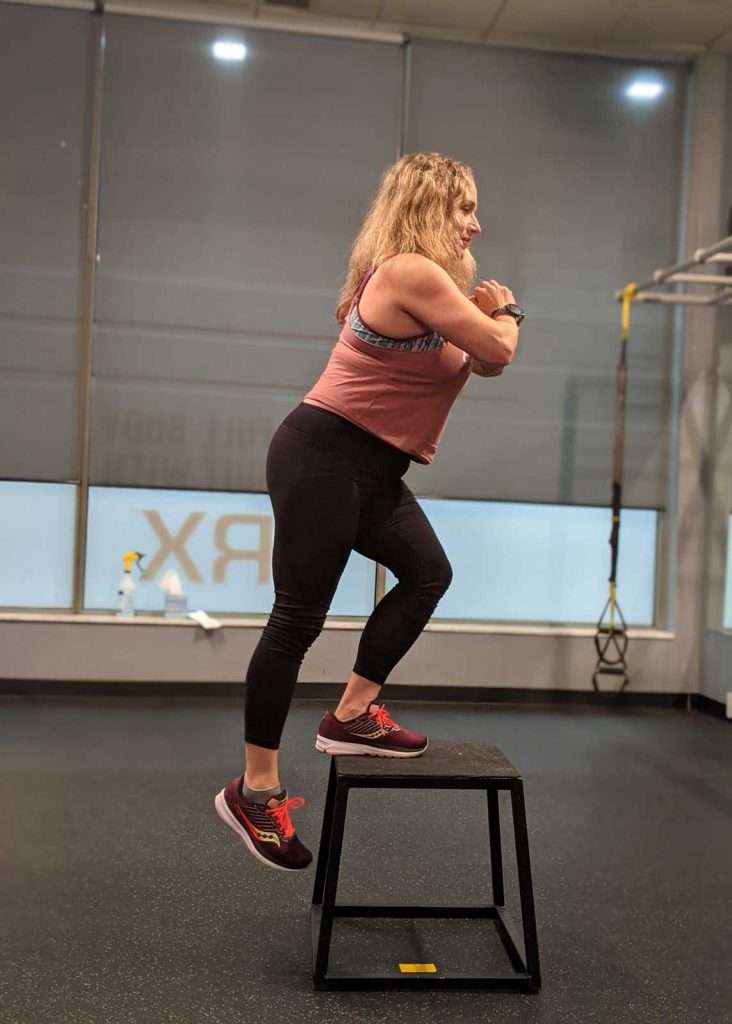
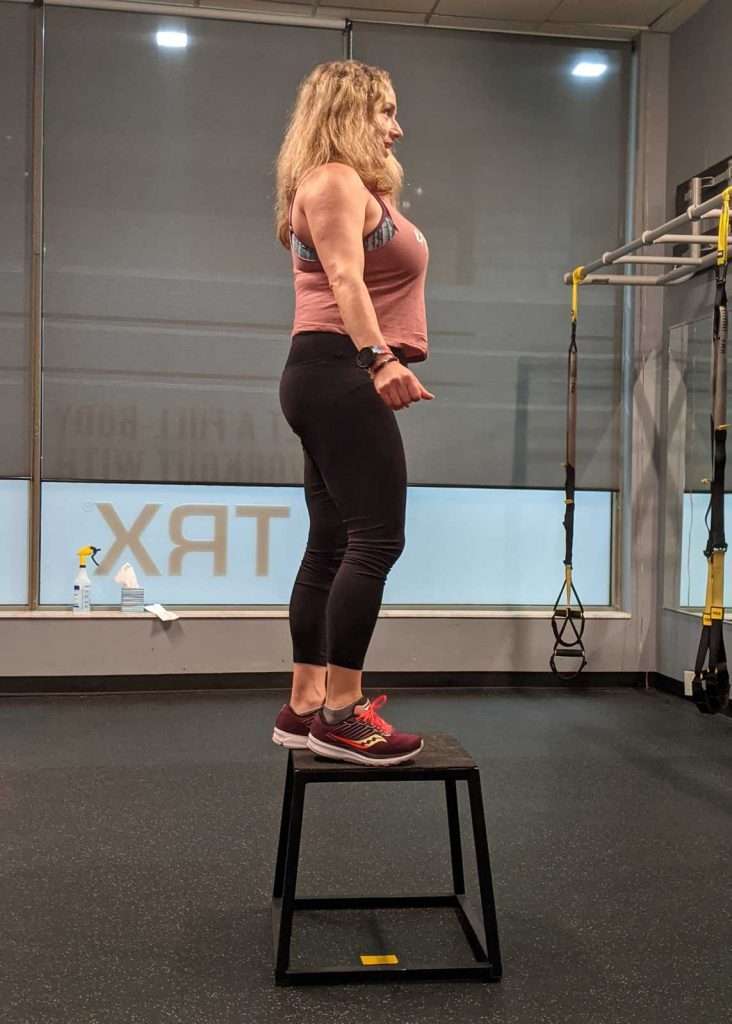
Best For: Elevation Gain
Preparing for that hike means teaching those legs to literally step up and then keep doing that! Do these fast to help build endurance and stamina (building that aerobic capacity!), or slowly to build even more muscle and control for your quad muscles.
For this exercise, you need some sort of step that’s a stable surface you can step up onto — a jump box works well or you can make it easier with an aerobic step trainer that’s not as high up. If you’re workin’ it from home and don’t have the fancy equipment, a stable chair, step-stool, or even a stair would also work.
Instructions:
- Start in front of your box with your feet shoulder width apart in a relaxed, balanced position.
- Step up with your right leg and place your full foot on the surface (no heels hanging off here, which can cause you to lose your balance or strain your knees).
- Bring your other leg up to meet it on the training box.
- Come to a full extension at the top, then slowly lower your left foot back down.
- At the bottom, switch legs and step up with your left leg in the same motion.
- Repeat.
Tips:
- Switch feet at the bottom, not the top of the box or bench!
- For faster feet here, just keep going! But if you’d like to slow down to really challenge and strengthen those glutes, hip flexors, and abdominals, try a step-down along with step up —leave one foot on the box or bench, and trace the second foot slowly down to the ground, trying to control as much as possible without “dropping” the foot!
- If you’re struggling with balance for stepping up, try a lower step or use a stick (hiking poles, anyone?), bar, or wall to stabilize you.
Reverse Lunges with a Kickback


Best For: Elevation Gain Climbing
We’re building legs that can climb for days with this combo exercise! This is body weight training at it’s finest. Make sure to pay close attention to your form to get the most out of each rep.
Instructions:
- Step your back foot back far enough that you could put your knee on the ground at the bottom (although stop before actually touching the ground).
- Control your back knee down into a lunge without hitting your knee to the ground.
- Stand back up and squeeze your glute to slowly raise that back leg up into a kickback.
- Keep your toes pointed towards the earth as you lift that back leg, and slowly lower it with control back into that lunge.
- Repeat on the same leg for however many reps you’re comfortable with, then do the same number on the opposite leg.
Tips:
- Aim to keep your front knee in line with your ankle as you control the back knee down.
- Don’t raise your front heel! Think of growing roots from your mid-foot into the earth.
Seated Rotations
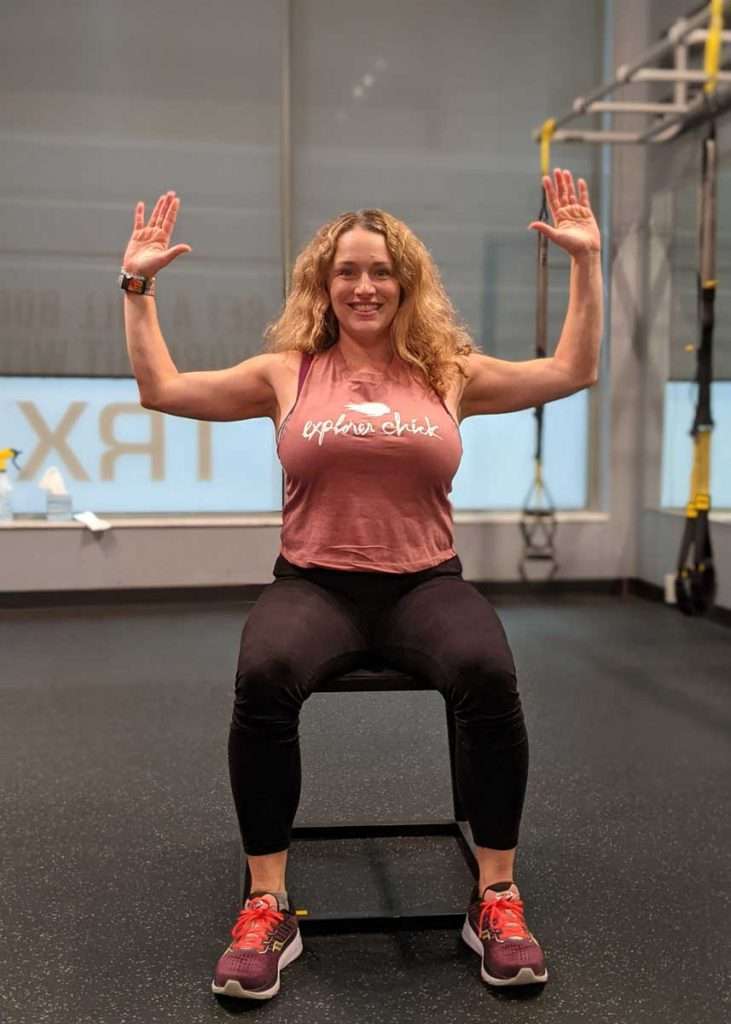


Best For: Core Muscles and Carrying that Pack
To prevent back pain, hip pain, and be able to carry that pack, working the core is essential! This exercise will work the back, abs, and even your upper body.
For this move, you need to have something stable to sit on — any flat chair (or that jump box from the step ups!) will work great.
Instructions:
- Start in a secure seated position with a straight spine.
- Open those arms like goalposts, and keep shoulders from sneaking up by those ears.
- Use big inhales and exhales as you twist from side to side.
Tips:
- Keep your ribcage over your hips.
- Keep that chest open; avoid collapsing forward.
Overhead Squat with Raised Arms
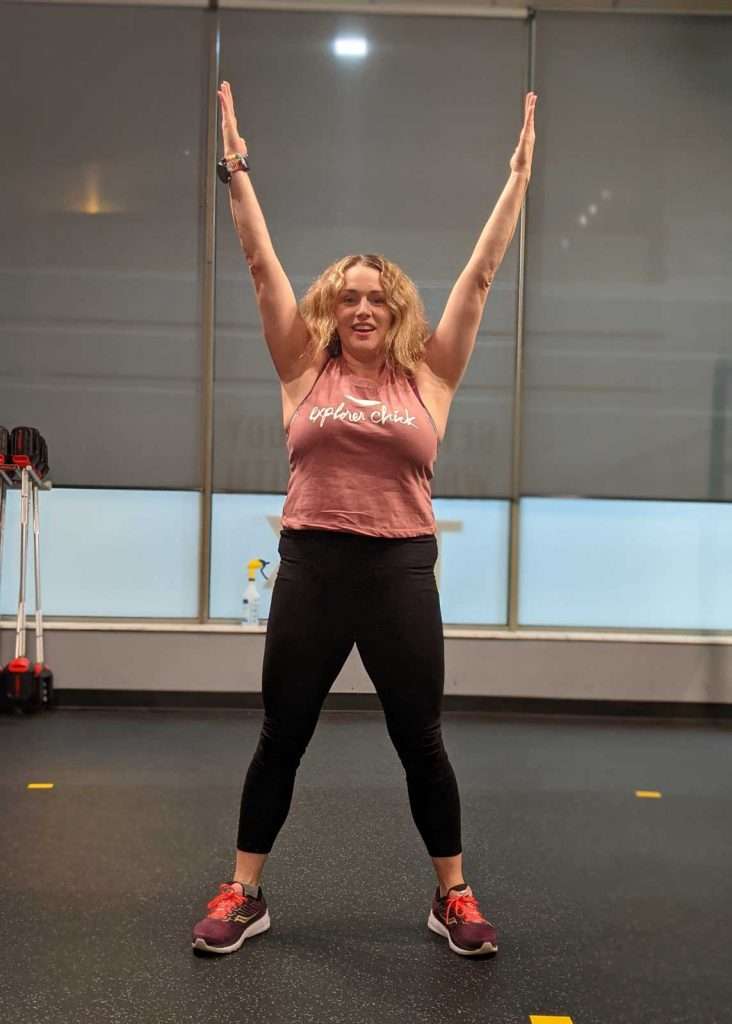
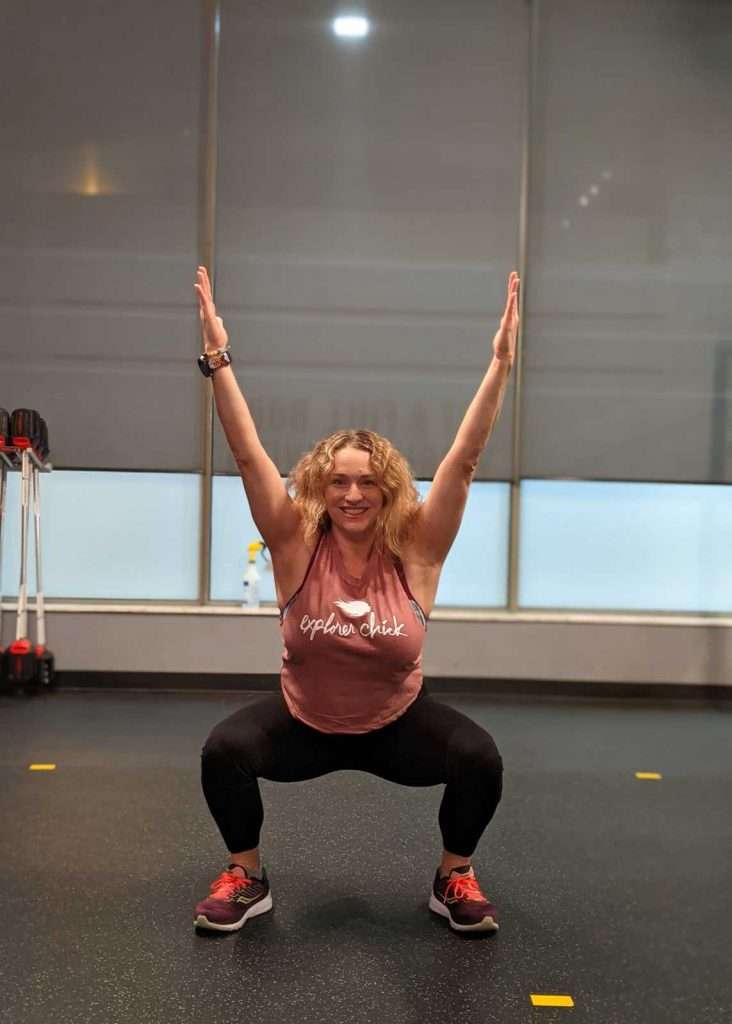
Best For: Total Body Stability
In this supercharged move, you’ll challenge your core, upper body stability, and your glutes and quads. This compound movement will prepare you for a successful hike without hurting the next day!
Instructions:
- Start in a standing position with a wide stance.
- Raise your arms and turn those thumbs behind you.
- Keep your top half stable and squat down, pushing your butt back and keeping your knees above your ankles (not shooting out past them).
- Engage those quads, glutes, and core to come back up to a standing position.
Tips:
- Feet should be wider than hip distance—you need enough space that your hiker booty can drop to at least parallel with your knees.
- For overhead squats, you may even need to be wider than a traditional squat to allow for dropping those hips as you lower towards the floor.
- Keep your front body stable and facing out as you squat, and keep your feet flat on the floor — no heel poppers here!
Sumo Squats with a Calf Raise
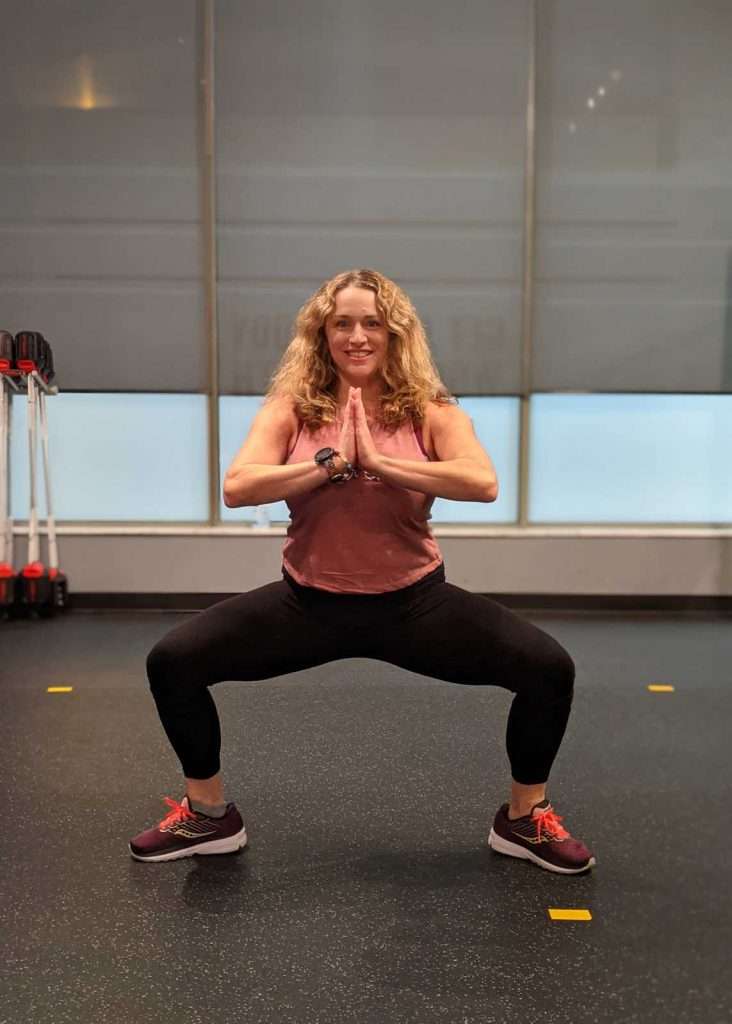
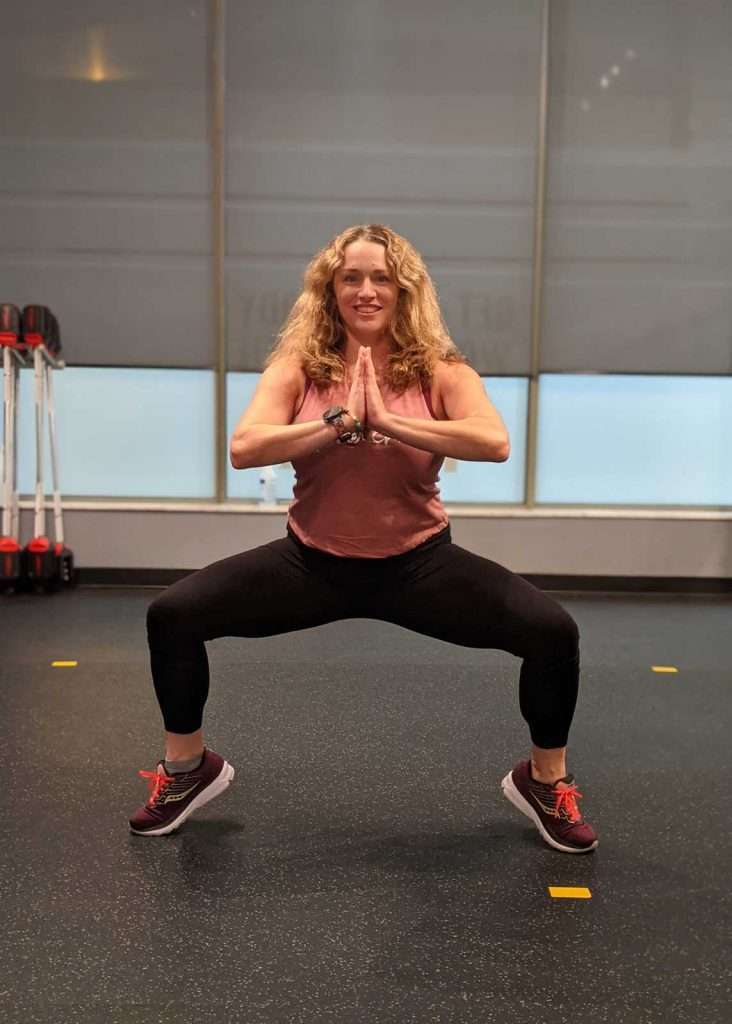

Best For: Ankle Stability and Hip Mobility
Hiking works the calves in a serious way! Prepare for that hike with these squats designed to strengthen your ankles and help your calves tackle those hills with ease and stability.
Instructions:
- Start with wide feet, toes pointed out at an angle — think about activating your inner thighs.
- Keep your chest open and drop your tailbone down toward the floor.
- At the bottom, lift one or both heels before controlling those heels back down.
- Squeeze your outer glutes (that side booty!) as you come back to your wide-leg stance.
Tips:
- Make sure your sumo squats are nice and wide—going too narrow can distress your knees. Those knees should actually stay in line with your feet.
- Keep your shoulders in line with your hips.
- Inner thighs, outer glutes, and low abs should also be feeling the burn.
Trip Specific Training Guides:
Training for Half Dome and Half Dome Cables
Training to Hike the Grand Canyon: Gear, Tips, and Exercises
Start Training!

Ready to hit your goal fitness level and start your training in a BIG way this year? Get stoked for Explorer Chick’s new Explorer Chick Fit program where you’ll get live, online workout classes specifically designed for preparing your body for the epic adventures you’ll accomplish this year!
Meet the Writer

Ulrike Rosser
Ulrike is an avid hiker, mountain biker, and outdoors enthusiast. In her free time, she trains personal clients and group fitness classes to the end goal of being fit enough to truly enjoy and appreciate a full, adventurous life.
Ulrike is TRX certified, Kettlebell certified, a NASM Certified Personal Trainer and Group Fitness Instructor, and a 200hr Registered Yoga Teacher through the Yoga Alliance. More importantly, she’s also certified by a few decades of life, which means she knows the pursuit for a perfect body (like what is that anyway???) is nowhere as important as a badass body that can climb mountains, throw on a pack (or pick up a kid), and meet all of life’s challenges with strength and capacity.
Read More Training Tips
- Training to Hike the Grand Canyon: Gear, Tips, and Exercises
- Knee Pain Hiking Downhill: Causes, Prevention, and Exercises
- Angels Landing: The Scariest Hike You’ll Never Forget
- How to Train for Hiking: 5 Moves to Get You into Hiking Shape
- Training for Half Dome and Half Dome Cables
- How to Choose the Best Hiking Boots for Women
- How to Start Backpacking: 6 Things You MUST Know
- How to Train for Hiking and Backpacking Trips


